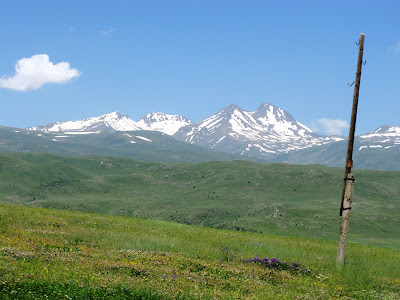 View from the road to Mount Aragat
View from the road to Mount Aragat In the villages on the mountain plateau cow dung is dried and used for fuel
In the villages on the mountain plateau cow dung is dried and used for fuel The new church in Spitak, the first bigger town on our way down fra the mountains.
The new church in Spitak, the first bigger town on our way down fra the mountains.The massive earthquake that struck Armenia on December 7, 1988 was epicentered in Spitak, taking at least 25,000 lives. Measuring 6.8 on the Richter Scale, the many poorly constructed Soviet buildings across the region sustained heavy damage or collapsed.
The small city of Spitak was destroyed, while the nearby cities of Gyumri and Vanadzor sustained a lot of damage as well. The tremor also caused damage to many surrounding villages.
Since most of the hospitals in the area were destroyed, and due to freezing winter temperatures, officials at all levels were not ready for a disaster of this scale and the relief effort was therefore insufficient.
 We were driving along the Pambak and Debed River. In soviet times a lot of industry was situated in the towns along the rivers, but not there are only ruins left.
We were driving along the Pambak and Debed River. In soviet times a lot of industry was situated in the towns along the rivers, but not there are only ruins left. Sanahin Monastery. Haghpat and Sanahin Monastery is situated in the Debed canyon close to Alaverdi, the last of the last of major industrial towns with their ruin of enormous soviet industrial complexes, situated on the road along the Debed River from Yerevan to Tbilisi.
Sanahin Monastery. Haghpat and Sanahin Monastery is situated in the Debed canyon close to Alaverdi, the last of the last of major industrial towns with their ruin of enormous soviet industrial complexes, situated on the road along the Debed River from Yerevan to Tbilisi. Built in the monastery over the centuries were more than 20 various churches and chapels, bell-towers, the building of the Academy, book depositories, refectories, galleries, bridges and other monumental structures, to say nothing of numerous dwelling and service premises.

 The bell tower of Sanahin Monastery
The bell tower of Sanahin Monastery Armenian gravestones tell stories. This about 3 sisters and one brother all killed in one car crash
Armenian gravestones tell stories. This about 3 sisters and one brother all killed in one car crash The bell tower of Haghpat monastery
The bell tower of Haghpat monasteryHaghpat monastery was founded, like Sanahin Monastery, by Queen Khosrovanush around 1000.
 Haghpat was major literary center, and maintained rich feudal lands until the monastery properties were confiscated by the Russian Empire in the 19th c.
Haghpat was major literary center, and maintained rich feudal lands until the monastery properties were confiscated by the Russian Empire in the 19th c.Haghpat and Sanahin Monastery are included in the UNESCO World Heritage List based on the following arguments: These two Byzantine monasteries in the Tumanian region from the period of prosperity during the Kiurikian dynasty (10th to 13th century) were important centres of learning. Sanahin was renowned for its school of illuminators and calligraphers. The two monastic complexes represent the highest flowering of Armenian religious architecture, whose unique style developed from a blending of elements of Byzantine ecclesiastical architecture and the traditional vernacular architecture of the Caucasian region.

No comments:
Post a Comment